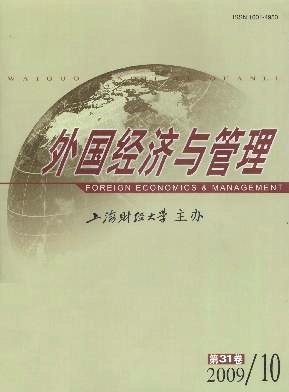论模块化组织的本质及其边界界定
外国经济与管理 2009 年 第 31 卷第 10 期, 页码:16 - 22
摘要
参考文献
摘要
本文基于交易费用理论和模块化理论深入探讨了模块化组织的本质。与已有研究主要关注产品和产业不同,本文把关注的重点放在了问题的原点——对活动的组织上,采用比较静态分析的方法,通过分析活动的任务网络特点来寻找与之相匹配的有效组织形态——市场、企业或者模块化组织,从而从理论上阐明了关于模块化组织本质的两个核心问题——存在原因和边界界定。
[1]Sturgeon,T.Modular production networks:A new American model of industrial organization[J].Industrial and Corporate Change,2002,11(3):.451-496
[2]Daft,R L,and Lewin,A Y.Where are the theories for the“new”organizational form?An editorial essay[J].Organization Science,1993,4(4):Ⅰ-Ⅵ.
[3]Schilling,M A,and Steensma,H K.The use of modular organizational forms:An industry-level analysis[J].The Academy of Manage-ment Journal,2001,44(6):1 149-1 168.
[4]Baldwin,C Y,and Clark,K B.Design rules:The power of modularity[M].Cambridge:MIT Press,2000.
[5]Baldwin,C Y,and Clark,K B.Managing an age of modularity[J].Harvard Business Review,1997,75(9/10):84-93.
[6]Sanchez,R.Strategic flexibility in product competition[J].Strategic Management Journal,1995,16(5):135-159.
[7]Garud,R,and Kumaraswamy,A.Technological and organizational designs for realizing economies of substitution[J].StrategicManagement Journal,1995,16(5):93-109.
[8]Langlois,R N.External economies and economic progress:The case of the microcomputer industry[J].Business History Review,1992,66(1):1-50.
[9]Langlois,R N,and Roberston,P L.Networks and innovation in a modular system:Lessons from the microcomputer and stereo compo-nent industries[J].Research Policy,1992,21(4):297-313.
[10]Schilling,M A.Toward a general modular systems theory and its application to inter-firm product modularity[J].Academy of Mange-ment Review,2000,25(2):312-334.
[11]Pil,F K,and Cohen,S K.Modularity:Implications for imitation,innovation,and sustained advantage[J].Academy of ManagementReview,2006,31(4):995-1 111.
[12]Sanchez,R,and Mahoney,T.Modularity,flexibility,and knowledge management in product and organization design[J].StrategicManagement Journal,1996,17(S.I.):63-76.
[13]Henderson,R M,and K B Clark.Architectural innovation:The reconfiguration of existing systems and the failure of established firms[J].Administrative Science Quarterly,1990,35(1):9-30.
[14]Langlois,R N.Modularity in technology and organization[J].Journal of Economic Behavior and Organization,2002,49(1):19-37.
[15]Brusoni,S,and Prencipe,A.Unpacking the black box of modularity:Technologies,products and organizations[J].Industrial and Cor-porate Change,2001,10(1):179-205.
[16]Langlois,R N.The vanishing hand:The changing dynamics of industrial capitalism[J].Industrial and Corporate Change,2003,12(2):351-385.
[17]Hoetker,G.Do modular products lead to modular organizations[J].Strategic Management Journal,2006,27(6):501-518.
[18]Baldwin,C Y.Where do transactions come from?Modularity,transactions,and the boundaries of firms[J].Industrial and CorporateChange,2008,17(1):155-195.
[19]Williamson,O E.The institution of capitalism[M].New York:Free Press,1985.
[20]Williamson,O E.Comparative economic organization:The analysis of discrete structural alternatives[J].Administrative ScienceQuarterly,1991,36(2):269-296.
①构成模块或子系统的既可以是企业内部的各个部门或业务单元,由此形成的作为整体的组织形式称为模块化组织;也可以是具有紧密合作关系的各个企业,由此形成的作为整体的组织形式称为模块化网络或簇群[4]。本文主要研究前者,文中的企业是指典型的科层制组织,与模块化组织是两种不同的组织形态。
②当然,科斯研究的组织形态是科层制企业,而本文研究的则是模块化组织。
③Baldwin认为,交易也是一种传递,只不过与一般意义上的传递相比,必须对交易的传递要素进行界定、计量和付酬。因此,与一般意义上的传递相比,交易更加标准化和正式化[。18]
[2]Daft,R L,and Lewin,A Y.Where are the theories for the“new”organizational form?An editorial essay[J].Organization Science,1993,4(4):Ⅰ-Ⅵ.
[3]Schilling,M A,and Steensma,H K.The use of modular organizational forms:An industry-level analysis[J].The Academy of Manage-ment Journal,2001,44(6):1 149-1 168.
[4]Baldwin,C Y,and Clark,K B.Design rules:The power of modularity[M].Cambridge:MIT Press,2000.
[5]Baldwin,C Y,and Clark,K B.Managing an age of modularity[J].Harvard Business Review,1997,75(9/10):84-93.
[6]Sanchez,R.Strategic flexibility in product competition[J].Strategic Management Journal,1995,16(5):135-159.
[7]Garud,R,and Kumaraswamy,A.Technological and organizational designs for realizing economies of substitution[J].StrategicManagement Journal,1995,16(5):93-109.
[8]Langlois,R N.External economies and economic progress:The case of the microcomputer industry[J].Business History Review,1992,66(1):1-50.
[9]Langlois,R N,and Roberston,P L.Networks and innovation in a modular system:Lessons from the microcomputer and stereo compo-nent industries[J].Research Policy,1992,21(4):297-313.
[10]Schilling,M A.Toward a general modular systems theory and its application to inter-firm product modularity[J].Academy of Mange-ment Review,2000,25(2):312-334.
[11]Pil,F K,and Cohen,S K.Modularity:Implications for imitation,innovation,and sustained advantage[J].Academy of ManagementReview,2006,31(4):995-1 111.
[12]Sanchez,R,and Mahoney,T.Modularity,flexibility,and knowledge management in product and organization design[J].StrategicManagement Journal,1996,17(S.I.):63-76.
[13]Henderson,R M,and K B Clark.Architectural innovation:The reconfiguration of existing systems and the failure of established firms[J].Administrative Science Quarterly,1990,35(1):9-30.
[14]Langlois,R N.Modularity in technology and organization[J].Journal of Economic Behavior and Organization,2002,49(1):19-37.
[15]Brusoni,S,and Prencipe,A.Unpacking the black box of modularity:Technologies,products and organizations[J].Industrial and Cor-porate Change,2001,10(1):179-205.
[16]Langlois,R N.The vanishing hand:The changing dynamics of industrial capitalism[J].Industrial and Corporate Change,2003,12(2):351-385.
[17]Hoetker,G.Do modular products lead to modular organizations[J].Strategic Management Journal,2006,27(6):501-518.
[18]Baldwin,C Y.Where do transactions come from?Modularity,transactions,and the boundaries of firms[J].Industrial and CorporateChange,2008,17(1):155-195.
[19]Williamson,O E.The institution of capitalism[M].New York:Free Press,1985.
[20]Williamson,O E.Comparative economic organization:The analysis of discrete structural alternatives[J].Administrative ScienceQuarterly,1991,36(2):269-296.
①构成模块或子系统的既可以是企业内部的各个部门或业务单元,由此形成的作为整体的组织形式称为模块化组织;也可以是具有紧密合作关系的各个企业,由此形成的作为整体的组织形式称为模块化网络或簇群[4]。本文主要研究前者,文中的企业是指典型的科层制组织,与模块化组织是两种不同的组织形态。
②当然,科斯研究的组织形态是科层制企业,而本文研究的则是模块化组织。
③Baldwin认为,交易也是一种传递,只不过与一般意义上的传递相比,必须对交易的传递要素进行界定、计量和付酬。因此,与一般意义上的传递相比,交易更加标准化和正式化[。18]
引用本文
曾楚宏, 朱仁宏, 王斌. 论模块化组织的本质及其边界界定[J]. 外国经济与管理, 2009, 31(10): 16–22.
导出参考文献,格式为:





 7205
7205  610
610

